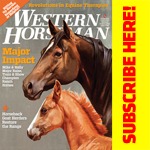It was 85 years ago that rodeo cowboys, tired of the way they were being treated by rodeo producers, signed a petition that led to the formation of the Cowboys’ Turtle Association, which is now known as the Professional Cowboy’s Rodeo Association.
By Randy Witte
This seldom-seen photo shows the cowboys walking out of the Boston Garden during their famous strike of the Boston Garden Rodeo, October 30, 1936. Hugh Bennett, the man credited with organizing the strike, is dressed in the light-colored pants and sport coat, leading the bald-faced horse.
Hugh was a top timed-event cowboy, a great horseman and successful rancher from Fort Thomas, Ariz., and later from Falcon, Colo., east of Colorado Springs. He was world champion steer wrestler in 1932, and went on to win the world title in steer roping in 1938. In those earlier days, championship points were compiled and titles declared by the Rodeo Association of America, an organization of rodeo managers. Until the Boston Garden strike, cowboys had no real representation in the rodeos in which they competed. But the strike changed all of that with the emergence of the Cowboys Turtle Association, so named by the cowboys “because we were slow as turtles gettin’ organized,” or “just like a turtle, we’re slow but sure.”
The strike came about after Hugh’s wife, Josie, did some calculating while sitting in the stands during a matinee rodeo performance. She looked up at a sign overhead which proclaimed the total amount of prize money that would be won at the rodeo. Josie knew how many contestants were entered in the rodeo and what their entry fees amounted to, and mentioned to Hugh that the advertised prize money was less than the fees alone totaled. Forget whatever money had been put up by the Boston Garden to bring the rodeo to town, a disproportionate share seemed to be going to the man who furnished the stock and produced the rodeo, Col. W.T. Johnson.
Hugh went to work “behind the scenes,” talking to cowboys, explaining the inadequacy of the prize money and circulating a petition which read: For the Boston Show, we the undersigned demand that the Purses be doubled and the Entrance Fees added in each and every event. Any contestant failing to sign this Petition will not be permitted to contest, by order of the undersigned.
Virtually all the contestants—61 signatures in total—signed up and the petition was given to Col. Johnson and the Boston Garden management. Meanwhile, the telegraph line was busy to Chicago, where The World’s Greatest Rodeo was going on. A lot of cowboys would contest in both rodeos in those days, and a similar petition was signed by the Chicago contestants, which read: We, the undersigned Cowboys showing at the Chicago Stadium do hereby agree not to go to the Boston Show, unless the demands of the Cowboys now at Boston are met. The boys at Boston now must be allowed to work and not (be) barred from that show.
Back in Boston, a performance was attempted using stable hands, but to no avail. The non-competing cowboys sat in the stands and hooted and hollered, and the audience, which had purchased tickets to attend the rodeo, was disappointed. The Garden management told Col. Johnson to make things right with the cowboys—or else. Johnson acquiesced, and the cowboys went back to work inside the arena.
The photo of the walk-out was organized for the Boston press, to make sure news of the strike and its consequences were well publicized. Hugh loaded up his rope horse with a trunk, suitcase and bedroll, to make it look like he was really headed home! In fact, the cowboys who bravely signed the petition didn’t know for certain their strike would work. Hugh advised Josie to look into arranging railroad transportation back home. Most of the cowboys and their horses had ridden east on the train Johnson had reserved, and Johnson was threatening to “turn you all out in the bay,” meaning they could all find their own ways home.
The CTA survived and grew. At the annual RAA convention in Reno in January 1937, Hugh Bennett addressed the attending rodeo managers and explained the goals of the CTA—all entry fees added to publicized purse money, a working relationship with rodeo management, and a pledge for rodeos to allow only CTA members to compete, along with local contestants. Also, there would be no more strikes by contestants.
At the CTA convention in Fort Worth, Tex., March 10, 1938, Secretary-Treasurer Hugh Bennett reported the association had 516 paid members and the bank balance was $4,623.34. By-laws were adopted and an election of new officers showed Everett Bowman of Hillside, Ariz., as president; Herman Linder of Cardston, Alta., first vice-president; Rusty McGinty of Plains, Tex., second vice-president; and Hugh Bennett, secretary-treasurer.
At a special meeting of the CTA in the Blackstone Hotel, Fort Worth, on March 16, 1945, the board voted to change the association’s name to Rodeo Cowboys Association. Headquarters would be moved from Phoenix to Denver, and pro rodeo was poised to enter a golden age. Thirty years later, the name of the organization would be changed again—to Professional Rodeo Cowboys Association.
This information came from a pleasant conversation with the late Hugh and Josie Bennett at their ranch near Falcon in the latter 1980s. Copies of various correspondence, and the strike photo were provided to me by Walter Dennis, a good friend to the Bennetts and a ranch and rodeo historian with whom I’ve exchanged a lot of information through the years.
And finally, the Cowboys Turtle Association has appeared in various forms through the years, i.e. Cowboys’ Turtle Association, Cowboy Turtles Association, etc. I have always used the first version, because that’s the way it appeared on the CTA stationary following the 1938 meeting, and that’s what the R.C.A. used in reference to the group when I worked for them 40 years ago.



